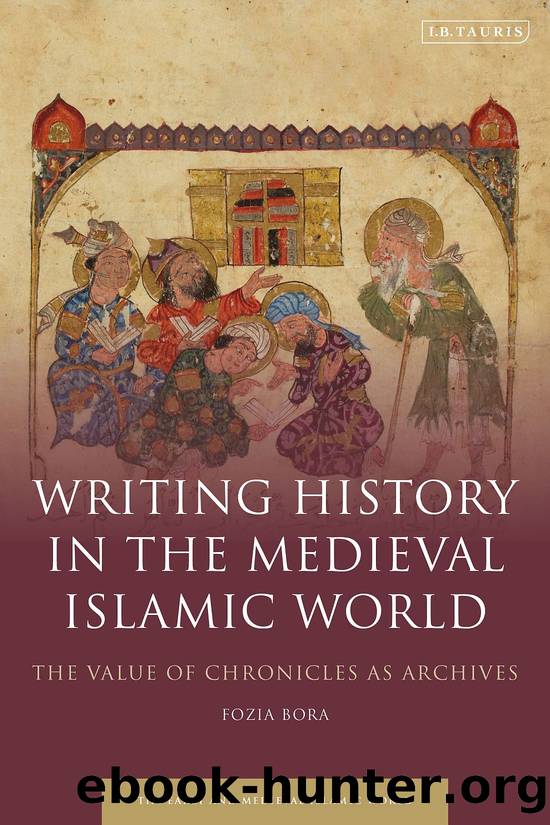Writing History in the Medieval Islamic World by Fozia Bora;

Author:Fozia Bora;
Language: eng
Format: epub
ISBN: 9781786726056
Publisher: Bloomsbury UK
The caliphate of al-FÄâiz and the vizierates of ṬalÄâiâ b. RuzzÄ«k and al-âÄdil RuzzÄ«k. The rise of the vizier ShÄwar
[sub annis 556/1160â1, 558/1162]
Ibn al-FurÄt covers the al-FÄâiz/ṬalÄâiâ era and the subsequent eighteen-month tenure of RuzzÄ«k over almost thirty pages, through four as yet unidentified reports and another five on the authority of the following:
⢠Nuzhat al-muqlatayn by Ibn Ṭuwayr
⢠al-Muntaáºam fÄ« taârÄ«kh al-umam by Ibn al-JawzÄ« (1114-1201)
⢠MaâÄdin al-dhahab by Ibn AbÄ« Ṭayy
⢠WafayÄt al-aâyÄn by Ibn KhallikÄn
The number and range of Fatimid-era reports available for the ṬalÄâiâ-RuzzÄ«k stage of Fatimid history are comparable to those available for the assassinations of al-áºÄfir and his family, but for the newer phase, the sources do not differ except in relatively inconsequential details. Unlike the spectrum of early views on al-áºÄfirâs death dispersed through the later sources, which sustain and perpetuate the controversy as Ibn al-FurÄt and Ibn TaghrÄ«birdÄ« elaborate, for this troubled period of Fatimid political history, some consensus emerges in the early sources, even in those at variance with one another on preceding events of Fatimid history. Several questions arise from this: to what extent do the sources agree on the outline for this eight-year period of Fatimid history, and how and why did the consensus, such as it is, materialize in the earliest contemporary sources?
To establish this relative consensus, one may observe the similarity of detail to be found in the following early sources on the issue of how ṬalÄâiâ came to Cairo during the âAbbÄs vizierate and the resulting departure, capture and death of âAbbÄs and Naá¹£r: Ibn Ṭuwayr (1130â1220), UsÄma b. Munqidh (1095â1188), the late twelfth-century BustÄn al-jÄmiâ, Ibn áºÄfir (1171â1216 or 1226) and Ibn Muyassar (d. 1287), who preserves extracts from earlier Fatimid-era historiography to take us to two years before the death of al-FÄâiz in 1160.24 All mention that ṬalÄâiâ came to Cairo from Upper Egypt to answer pleas for help from the Fatimid house against âAbbÄs, murderer of the caliph al-áºÄfir. Each describes the defeat of AbbÄs at the hands of ṬalÄâiâ. Most accounts also allude to his discovery of the former caliphâs body, interred under the house of Naá¹£r, and his arrangement of a state funeral and burial for him, all using similar wording. The main discernible exception to this agreement of reportage is that UsÄma, writing his experiences many decades after they took place, recalls a battle between ṬalÄâiâ and âAbbÄs outside Cairo before the latter flees.25 Yet the other sources, including the book of Ibn Ṭuwayr, who was in Cairo at this juncture and offers the temporally closest account, describe a bloodless coup.26 The disparity between reports by UsÄma and Ibn Ṭuwayr is easily explained: the tendency towards hyperbole in UsÄmaâs memoirs, as he tries to magnify and embellish the rectitude or heroism of both himself and those whom his allegiance â and therefore narrative â favours, is self-evident. On the other hand, Ibn Ṭuwayr, though a ḤafiáºÄ« author, appears a more reliable narrator with an unsentimental style of both observation and presentation, whose account was written well after the Fatimids fell.
Download
This site does not store any files on its server. We only index and link to content provided by other sites. Please contact the content providers to delete copyright contents if any and email us, we'll remove relevant links or contents immediately.
Cecilia; Or, Memoirs of an Heiress — Volume 1 by Fanny Burney(32438)
Cecilia; Or, Memoirs of an Heiress — Volume 2 by Fanny Burney(31875)
Cecilia; Or, Memoirs of an Heiress — Volume 3 by Fanny Burney(31858)
The Great Music City by Andrea Baker(31530)
We're Going to Need More Wine by Gabrielle Union(18972)
All the Missing Girls by Megan Miranda(15594)
Pimp by Iceberg Slim(14398)
Bombshells: Glamour Girls of a Lifetime by Sullivan Steve(13978)
Talking to Strangers by Malcolm Gladwell(13232)
Norse Mythology by Gaiman Neil(13213)
Fifty Shades Freed by E L James(13162)
For the Love of Europe by Rick Steves(13102)
Mindhunter: Inside the FBI's Elite Serial Crime Unit by John E. Douglas & Mark Olshaker(9206)
Crazy Rich Asians by Kevin Kwan(9171)
The Lost Art of Listening by Michael P. Nichols(7411)
Enlightenment Now: The Case for Reason, Science, Humanism, and Progress by Steven Pinker(7240)
The Four Agreements by Don Miguel Ruiz(6639)
Bad Blood by John Carreyrou(6558)
Weapons of Math Destruction by Cathy O'Neil(6152)
